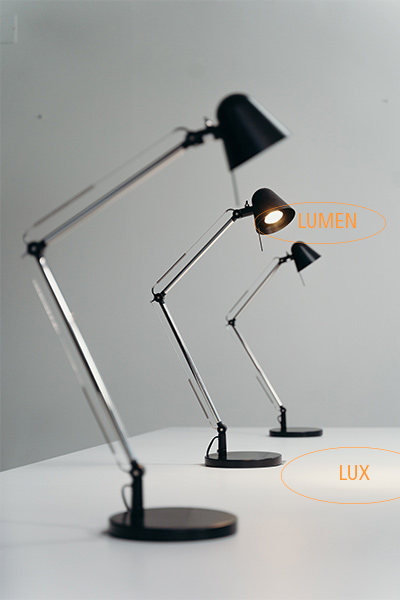Brightness is a subjective perception. Whether we perceive a room as bright or dark depends, among other things, on our visual acuity and the brightness of the surroundings. In lighting technology, however, there are objective measures of brightness. Of these the best known are lux and lumen. In this article, we explain how lux and lumen are defined and how they differ.
What Is Lumen?
Lumen is the standardised unit for luminous flux, i.e. the amount of light emitted by a light source per unit of time in all directions. The unit of time is quasi = 0 due to the speed of light of 300,000 km/second, as the speed of light forms our perceptual limit. This unit is often used to evaluate the performance of lighting fixtures. Many manufacturers use lumens to indicate the brightness of their products. Lumen is therefore also often referred to as light output, i.e. how brightly a lamp shines.
What is Lux?
Lux is a unit of measurement that indicates luminous intensity or brightness. It is expressed in the International System of Units (SI) as lx. Lux is the illuminance per square metre and indicates how much light falls on a given surface. Unlike lumen, which measures the total luminous flux, lux only measures the amount of light in a specific area.
How are Lux and Lumen measured?
Measuring lux and lumens is not only important for determining the brightness of a room, but also for many other applications. The most common methods of measuring light are: Photometer, Luxmeter and Luminometer.
A photometer measures the amount of light in relation to the angle of incidence. It is able to measure the intensity of light at different angles. This data can then be used to determine the power of the light.
A luxmeter measures brightness based on the amount of light reflected in the room. It can be considered a kind of “light sensor” and measures the value based on the reflected light. The luxmeter can help to find the right amount of lighting for a specific purpose.
A luminometer measures the absolute light intensity. It is often used in industrial applications to find out how much energy there is in the room — so it allows you to calculate the current light intensity and thus determine whether more or less lighting is needed.
There are other types of devices for measuring lux and lumen, but these three are the most commonly used methods. They also provide accurate results – which is very important for professional applications. Properly measured values help determine the most optimal use of different lamp types and colours, as well as the perfect compromise between brightness and energy consumption.
The Importance of Lux and Lumen
The relationship between lumen and lux can therefore be described as follows: Lumen corresponds to the amount of light that is emitted. Lux corresponds to the intensity of the light on a given surface.
To better understand the relationship between lumen and lux, consider the following example: Suppose you have two identical lamps, each with 100 lumens. The first lamp shines in a small room measuring 3 m x 3 m; the second lamp shines in a larger room measuring 6 m x 6 m. In both rooms you have the same amount of light (100 lumen), but because of the different size of the rooms the Illuminance (lux) varies.
Conclusion
In lighting, both the brightness and the quality of light play a significant role. Therefore, it is important for us to correctly understand the units LUX and lumen and to take them into account when planning lighting.
It is important to become familiar with these two units when planning lighting systems. This is the only way to ensure that we plan the appropriate number of lamps and thus save energy. It also enables us to illuminate the most adequate place and achieve the best possible result.
Because of its importance for our everyday lives, it is important to deepen your understanding of light and to keep abreast of new developments in lighting technology. After all, more modern technologies can create brighter and more energy-efficient systems that offer the greatest possible efficiency while at the same time providing pleasant atmospheres.
With this advanced knowledge, you can be sure of always achieving the best results in the end – both for your wallet and for the comfort of the users.



